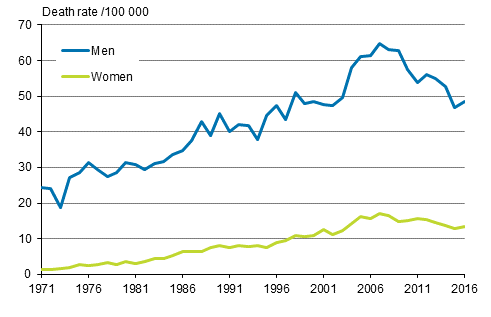4. Slight growth in alcohol mortality from 2015
The decrease in mortality from alcohol that started in 2008 did not continue in 2016. In 2016, mortality from alcohol grew somewhat from the previous year but was still lower than in 2014. In 2016, more than 1,700 persons died from alcohol-related diseases and alcohol poisonings of whom around 1,300 were men and 400 women. The share of alcohol-related causes in all deaths was three per cent.
Changes in alcohol-related mortality has followed fairly regularly the graph for total consumption of alcoholic beverages even though alcohol-related deaths usually call for long-term detrimental use of alcohol that lasts for several years. The changes in the number of deaths from alcohol-related causes between 2009 and 2016 were mainly caused by changes in men's deaths from alcohol-related causes (Figure 7).
Several different alcohol-related diseases used as primary causes of death and accidental alcohol poisonings have been collected into alcohol-related causes of death. Diseases related to long-term alcohol use, such as liver and heart diseases, cause a majority of deaths from alcohol-related causes. The share of alcohol poisonings in deaths from alcohol-related causes has decreased from 28 to 15 per cent over a ten-year period. In 2016, altogether 256 persons died from alcohol poisoning of whom three out of four were men.
Fewer people die of alcohol-related causes than from neoplasms or diseases of the circulatory system. However, more working-age persons still die of alcohol-related causes than of individual neoplasm types or ischaemic heart diseases. In addition, alcohol is a contributing factor to death in many fatal accidents. The share of intoxication in accidents will be discussed in the following section.
Figure 7. Age-standardised mortality from alcohol–related diseases and accidental poisonings by alcohol and total consumption of aclohol in 1971 to 2016

Men die from alcohol-related causes considerably more often than women (Figure 8). Male mortality has also followed more closely changes in total consumption of alcohol. Women are lagging behind in alcohol statistics but women's mortality from alcohol-related causes has also risen over several decades following men's mortality from alcohol-related causes. In 2016, men’s alcohol mortality was one-fifth lower than in 2006.
Persons who died of alcohol-related causes are older than before. During the past ten years, mortality from alcohol among both men and women aged 65 or over has grown while, correspondingly, in younger age groups mortality from alcohol has decreased. Two-thirds of persons who died of alcohol-related causes are still of working age but alcohol mortality of persons aged over 65 has also grown from 18 to 36 per cent over the past ten years. In 2016, the average age of persons dying of alcohol-related causes was 60 years for men and 62 years for women.
Figure 8. Age-standardised mortality from alcohol-related diseases and accidental poisonings by alcohol in 1971 to 2016

Source: Causes of death, Statistics Finland
Inquiries: Airi Pajunen 029 551 3605, Jari Hellanto 029 551 3291, Kati Taskinen 029 551 3648, kuolemansyyt@stat.fi
Director in charge: Jari Tarkoma
Updated 29.12.2017
Official Statistics of Finland (OSF):
Causes of death [e-publication].
ISSN=1799-5078. 2016,
4. Slight growth in alcohol mortality from 2015
. Helsinki: Statistics Finland [referred: 26.12.2025].
Access method: http://stat.fi/til/ksyyt/2016/ksyyt_2016_2017-12-29_kat_004_en.html

